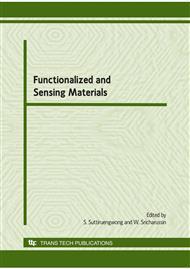p.635
p.639
p.643
p.647
p.651
p.655
p.659
p.664
p.668
Color Tolerance of Identity Color of Chulalongkorn University on General Print
Abstract:
Chulalongkorn University has a long historical background. Pink color is known as the identity color. To be more specific on which pink colors of general prints are acceptable for the identity color of Chulalongkorn University, printed samples with the identity color were collected and measured to find the differences among the printed colors. Then the Natural Color System (NCS) colors were determined corresponding to the printed samples. The obtained NCS colors were used as samples in the experiment. A standard color was obtained from the color of pink cushion placed under Prakeaw, an emblem of Chulalongkorn University. Measurements were taken at the same specific light source as in printed samples. Comparison was then made to determine the color tolerance. A method of pass/fail tolerance was adopted to evaluate the optimum color difference between the identity color and the color of general prints by comparing the results of color measuring device against that of visual assessment. A group of 101 observers were involved to find their perception acceptability of printed pink samples against identity color or standard pink color. The color different equations, E94 and CIEE2000 were employed.
Info:
Periodical:
Pages:
651-654
Citation:
Online since:
January 2010
Authors:
Keywords:
Price:
Сopyright:
© 2010 Trans Tech Publications Ltd. All Rights Reserved
Share:
Citation:


